I am often surprised at the simplicity of (and sometimes statement of the obvious) of Montessori at Home posts. Recently, a friend of mine asked me to explain Montessori to her.
As I explained Practical Life aspects, she looked at me and said, “Aren’t children already getting that stuff at home anyway? Why do they have to go to school for it?”
Yes and no, mostly no.
Montessori schools create an environment that even with the best efforts a home cannot achieve for children. That is maybe more of my opinion than fact.
Yet, three key tenets such as the completion of the work cycle, isolation of quality, and control of error are challenging to achieve in a home environment and in your role as a parent. #truth
Now, it is certainly possible to achieve, just more difficult. Each of these aspects is critical to the execution of Montessori at home and in the classroom.

How to Bring Montessori into Your Home
#1 – Laundry
So, that brings me to this Practical Life Project Montessori post about The Hamper. In an effort to organize our home we recently purchased two laundry hampers. One for our room and one for our boys.
It occurred to me that this hamper is nicely integrated into our desire to place a Montessori overlay on our home mostly for our boys but definitely a part of the desire is helpful to us, too. Any seconds of a chore taken away from us is deemed helpful in our book!
I didn’t even have to introduce the hamper to my then 2.5-year-old. He immediately noticed it and was curious about it. So, I explained how we put dirty clothes in it and bring it to the laundry room when it gets full. I explained it as a ‘we’ not a ‘mama and daddy’. This Montessori thing is a family effort, all hands included…
So as we prepare his bath at the end of the day, he happily brings his clothes (and his younger brother’s clothes) over to the hamper.
Then when the hamper was full he ‘helped’ me carry it over to the washing machine and load up the machine with dirty clothes. First, though, we sorted lights and darks (there are hampers that have separate baskets for lights and darks). Then, shocker, he likes to put soap in and start the machine.
Transferring the load of wet laundry is also quite fun and interesting for him (I know this fun won’t last but at least he’ll learn something!). So he helps me transfer the clothes into the dryer and, of course, start the load.
#2 – Nature Basket
Maria Montessori believed nature was an inspiration for learning. As many of us witness on a daily basis, children are fascinated with nature. Montessori encouraged teachers to take their classroom outside and to get the children out into nature because there is a lot to learn but also because it inspires a “natural” desire to learn.
So, with that said, now that the rapid change of seasons is upon us (well, at least here in Seattle) and the temperatures declining at a fast pace, I am more conscious of making sure we get outdoors for exploration and some days simply for fresh air and a bit of sunlight. So I am particularly focused on our Nature Basket.
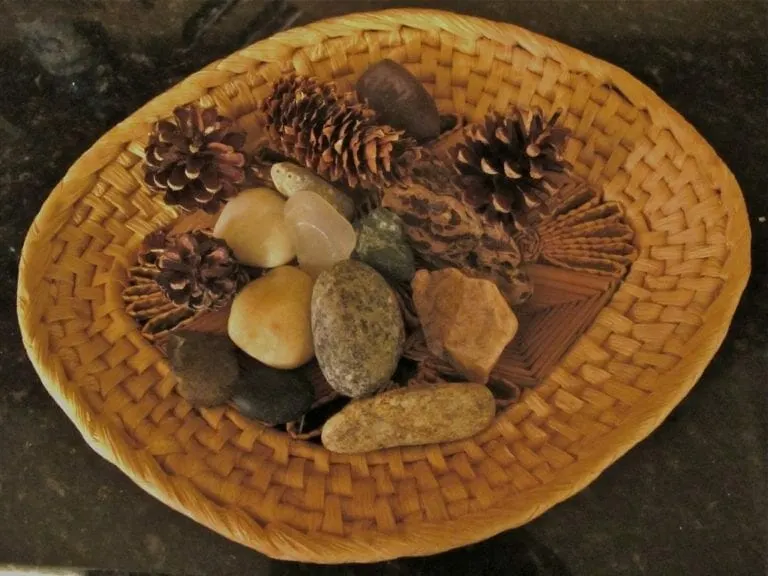
My then two-year-old is definitely interested as we’ve added items he’s collected over the past several months. The basket is a lovely reminder of the place we’ve traveled and explored and also a reminder of the great outdoors. I imagine as my sons grow older they will be a bit more into the concept but for now, simply seeing the collection is joy enough for this household.
Creating a nature basket is super easy to do! All it takes is a basket (I purchased this one at Goodwill for $1.50) and items collected from the outdoors like shells, rocks, pine cones, etc. We place our basket out in the open so that it simply exists in our space.
You might also enjoy the post about our Natural History Museum at Home
#3 – Displaying Art
In our effort to de-clutter, I knew I was keeping my old college art history books around for a good reason. The project with our toddler was fun and the best part is that the “art” education part of it has only begun for us.
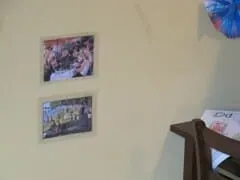
I pulled out my trusty laminating supplies, which was enough to get my then two-year-old interested in the project. Then I grabbed four thick art history books, settling on impressionism to begin our project.
My little man and I flipped through the pages and I asked him to choose his favorites. Turns out he has great taste as he chose two prints, a Seurat and a Renoir, to cut out, laminate, and hang at his eye level in the activity area.
#4 – Dressing Basket
Involving fine motor and practical life skills, dressing is a big step for young children. The ability to dress oneself fosters independence and helps develop self-esteem. Who knew you could get all that good stuff from putting a sock on?
As you can imagine, however, dressing provides challenges. For example, my two-year-old races in the other direction even if I can manage to (help him) get his pajamas off and get a clean diaper on.
So, we came to a middle ground and implemented the What I’m Going to Wear Today Dressing Basket, a creation driven by two facts: 1) Like many two-year-olds, my child would rather run around naked or stay in his pajamas all day than getting dressed, and 2) although my son’s dresser is within reaching height for him, opening and closing the drawers gently and softly has proven to be a challenge. We’ll get to that Practical Life lesson.
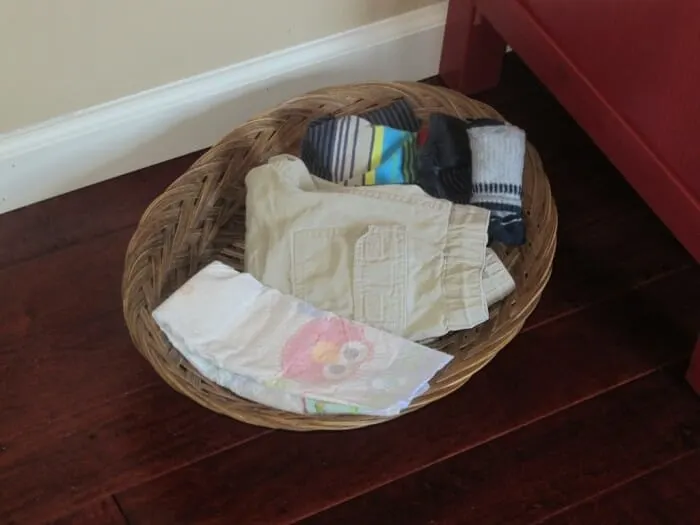
Location: I place it neatly next to his dresser in his bedroom.
What’s Included: Include the basics: a shirt, a pair of pants or shorts, socks if necessary and a diaper. You might want to include a sweatshirt or something extra your child might need for the day. Â Ideally this basket goes under or near a low coat rack (we’re in the process of purchasing one).
How We Do It: At this point, I place these items in the basket. The next step in the process of independent dressing is to have him fill the basket and then ultimately remove the basket (if it makes sense for him). We always start the dressing process with our son at least attempting to remove his clothes. Then we gently guide him to successfully get out of his clothing. Usually, this guidance involves helping a shirt over an elbow or providing a shoulder to lean on so he can step out of his clothes.
The results so far have shown that he relishes independence. When I say that we are going to change out of our pajamas, he doesn’t fight me (sometimes I have to remind him of the dressing basket) and runs excitedly to his dressing basket to grab his clothes for the day.

The beautiful part is seeing your child’s face light up in the “I did it!” way when you can see the self-esteem building in his body. Sounds strange to say but I enjoy this moment even more after there has been a bit of frustration, a point when he truly learned to “do it all by himself†and gained confidence that will help him through his entire life. It seems like such a small and simple way to help develop such profound life skills, right? I love every minute of it.
#5 – Music Basket
In my quest to transition our home into a Montessori environment, my next step was in the activity area: the music basket.
The BASKET: Good thing I love baskets because this Montessori project (erh…for the next decade or so) does require quite a few of them for activities and storage. I found our “music” basket at Target for ten bucks. Since then I have found numerous Montessori-Esque baskets at consignment stores for very inexpensive. With that said, if you don’t have the time to wander the consignment stores, order online! You can find great deals!
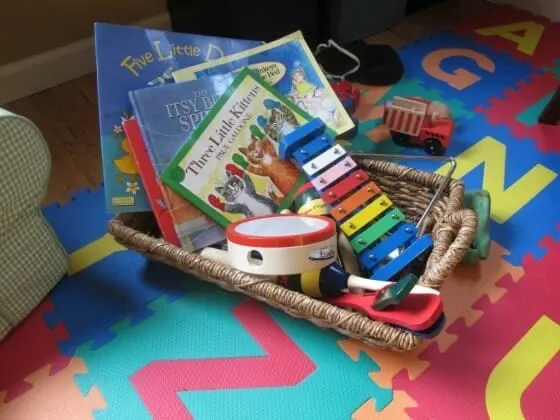
Books and Instruments
We currently keep this basket in the activity/play area near our reading corner. I want my boys to connect books and songs with musical instruments so I am bringing the areas physically together. So included in our music basket are not only instruments but wonderful books made from traditional songs on which we all grew up.
For example, Three Little Kittens, Itsy-Bitsy Spider, The Little White Duck, Five Little Monkeys, etc. There are some great songs to get the little bodies moving too. So when I see my sons migrating to the music box, I make sure I am situated near enough to them so that they can access me for reading and singing.
It works every time.
We’re almost always listening to music during this time too. At this point, we don’t have a set schedule for “music” but typically music is a stopping point during “free” play or “choice time” in the morning.

A huge bonus to the basket is that it lets my boys know “the instruments and songbooks belong in this basket”. Everything has a place, which is great for us parents, but this approach does wonders for children who crave order (we just don’t always indulge them or even know this is the case).
I am not sure if my sons will be musicians in the future – they definitely don’t have any help with the “no rhythm” gene from both parents – but I do know that music is having a profound impact on our family and on their development.
I have grand ideas with the music “area” of our impending Montessori home school environment/classroom tying music to geography, history, and culture. For example, recently, I saw the most amazing map on an outing to our Symphony’s children’s program space called Soundbridge.
The map was a very large wall world map. There were arrows from images of instruments pointing to various countries, some countries, and instruments obscure and some not. This map gives children a wonderful visual of world music. The map, honestly, gave me chills. Super powerful. So, I’d like to include something like that map in our music space.
Again, here is what you need:
- Medium-sized basket
- Melissa & Doug’s Band in a Box
- Any sort of rattle or shaker
- Various books and stories created from songs
#6 – Breakfast
One step at a time. You can say that again. So I cleared out a few shelves in a cabinet that my two-year-old can access. He is very excited about this change. In true Montessori form, he thrives on doing things by himself. He dives into the opportunity to be independent, self-sufficient, and take care of himself. Those observations are heartwarming to watch on a daily basis.
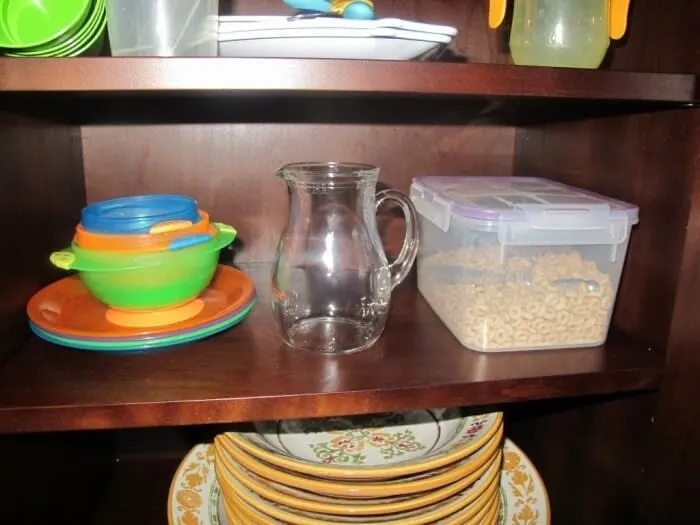
I filled the cabinet with his dishes, utensils, placemats, and cups. The next step was to include food items. I decided to start with breakfast. I filled a snap-top food storage container with cheerios and included a scoop for my little guy. I also purchased, bravely, a mini glass pitcher for him to pour his own milk. I also place a banana on a plate with a (dull) knife for him to add to his cereal.
Beginning this process requires a lot of patience. Bringing Montessori into the home is new to me and new to my two-year-old. He is young and we are green at this Montessori thing. So I begin each morning with a few “Om shantis” and deep breaths. Then, I admit, I take a break in the middle of the “experience” to say a few more “Om shantis” and take a few more deep breaths to get through the hour.
The silver lining is that he is thrilled to be pouring and scooping. The tough part for me is watching him scoop too much, spill cheerios, pour too much milk, etc. I learned a few lessons: only give him the milk he needs in his pitcher and use the scooping as a number exercise (e.g. okay, let’s count to three scoops…).
I am happy with the changes so far but am reminded, particularly with the practical life exercises, that I am an observer who should guide my child’s learning not dominate it. So, patience is a must, folks.
#7 – The Placemat
Montessori is all about self-directed learning. Mealtime is a great opportunity for encouraging this sort of learning and watching your child’s confidence build as a result. One super-easy way to start this process is by using Montessori-inspired placemats.
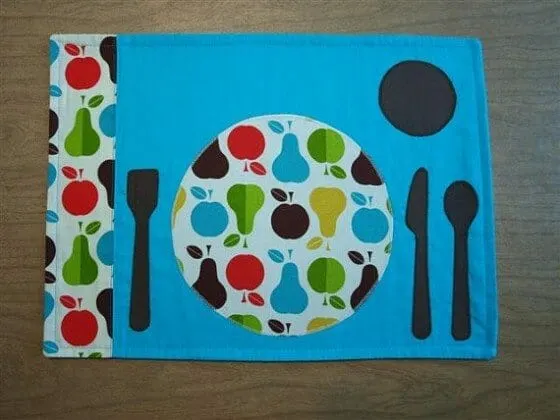
Now, our two-year-old helps us set the table. He takes pride in helping us and in setting the table properly. We were having snack time outside of the house the other day. The adult in charge placed his cup off center and my son politely said, “No, right here,” and then placed it properly on his mat.
Keep in mind that in order for your child to use this placemat, you must keep the mat and all the goods that go along with it (plates, cups, etc) in a drawer or cabinet easily accessible to him. This change was implemented a few weeks ago at our home.
Not only can he help set the table but he can help put (his) dishes, cups, etc away after a meal and dishwashing. As with most learning activities, the transformation does not happen overnight but it will happen. I admit, too, that there are some days when setting the table myself is easier and quicker. So be prepared for that tug and pull. Have patience and strength in yourself too!
The result is brilliant and, at times, unbelievable. Give it a try.
#8 – Our Mornings
Here is an example of work I may leave out for my two year old:
- A treasure basket filled with eye spy bottles, a random assortment of animal figurines, fake eggs, Elmo “eggs”, a strainer, lentils, colored rice, and gems!
- A butterfly matching and memory game set up on a bamboo mat
- I pulled the numbers out from our activity mat so my little guy can work to put them back in place
- A DIY match the shape game made from cardboard using an x-Acto knife and foam shapes from Dollar Tree
- A food storage container filled with buttons and a Pyrex 2 cup measuring cup on a bamboo mat for a pouring exercise
- A food storage container with “cloud” dough (oil and flour) that my little guy can take OUTSIDE in the morning to get his hands all crazy
Other Montessori at Home Ideas
- Daily Hygiene Tray
- Montessori Bathroom
- Montessori Bedroom
